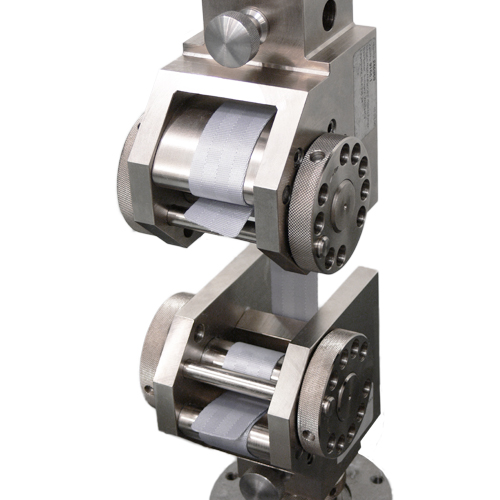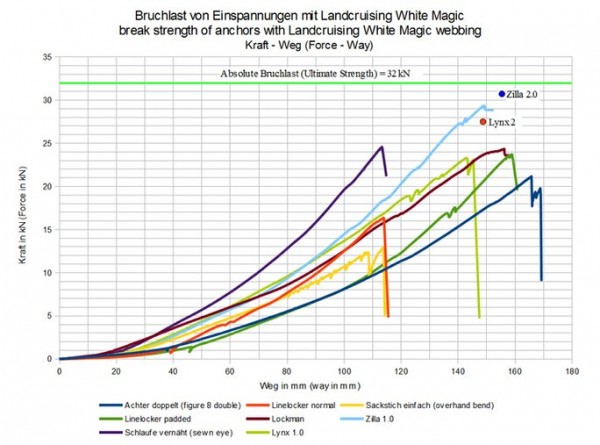This article was originally published in spring 2014 within the SlackLab project. I have made minor updates to the republication on the Aki Slacklines website.
This article will discuss the various anchoring options of slackline webbing. The investigation uses the very widespread White Magic webbing. White Magic is a webbing made of polyester fibers in a 2 layer design with moderate strength of min. 30 kN and relative low stretch of 5% at 33% of its break strength (e.g. 10 kN).
Content
1. Explanation of the testing setup
2. Detailed informations on the tests
2.1. Factory testing of the free length strength
2.2. Knots
2.3. Linelockers (chain links)
2.4. Ringlockers (rings + shackles)
2.5. Boltlockers
2.6. Sewn Loop
2.7. Banana weblocks
2.8. Special High Strength Anchors
2.9. Investigations on old webbing
3. Summary and discussion
1. Explanation of the testing setup
Based on the tensile strength in the free length, which is approved by the manufactuer with every batch production, there were various webbing anchors analyzed on lab testing machines since 2009. Special thanks is contributed to Institute of Solid Mechanics of the Technical University of Dresden for providing the testing fascilities. New webbing was used for every break test. Partly a red sibbling of White Magic (Verve) with the same strength was used. The value of the break load efficiency of every anchor refers to 32 kN (the absolute strength of White Magic). All tests were run at low speed. Old webbing was tested in a separate investigation for developing conclusions about the fatigue behaviour and failure load reduction.
2. Detailed information on the tests
2.1 Factory test of the free length strength
The webbing manufacturer tests with every batch the absolute breaking load and the stretch parameters of the webbing. An amount of 3 test samples is used to give informations on the scatter. The results are written in the inspection report.

- Zwick webbing testing machine
The free length strength is tested on tensile testing machines of the company Zwick. The anchoring is carried out over big webbing sample holder. This ensures that the webbing does not break inside the anchor, but in its free length. Thus the absolute breaking strength of the webbing can be achieved.
The strength of the webbing is part of the product definition and must always be greater than 30 kN for the White Magic webbing. Since webbings are subject to certain fluctuations due to there manufacturing process, the strength of the webbing is made somewhat higher from the outset. White Magic has for all batches a strength higher than 32 kN (100%) and an average strength of 33 kN.
2.2 Knots
Knots provide the easiest way to attach a slackline to a carabiner or shackle. Knots are used to achive a backup behind the webbing main anchor. Therefore a knowledge of the breaking load reduction is also very important. We examined all slackline relevant knots. All knots have the weak point of loading the webbing in a local point and asymmetrical, so their breaking load efficiency is in general fairly low. In following the presentation of results:
|
| |
|
The Munter Hitch with slip knot is used in very simple, traditional slackline setups with very low tension. The slip knot can be opened under load. This provides a very simple method of loosening the line. The Munter Hitch breaks at 15,5 kN (48%) with the White Magic webbing. The breaking point is directly on the node input of the outgoing tensioned webbing. In the test, a significant stick-slip was observed. Yet, the break of the webbing was reached. . |
|
| |
| The Clove Hitch is a very simple attachment knot, which can be tied quickly and allows a fine adjustment of the length even when the knot is threaded. The strength of the Clove Hitch is similar to the Munter Hitch. The webbing breaks at about 15 kN (47%) at the node inlet of the tensioned webbing. |
|
| |
| The Overhand Loop Knot is probably the easiest and most well known knot in general. In climbing, the knot is also known as Water Knot. Its pretty easy to ty a loop for attachment with him. However, the strength values of both the overhand bend and the water knot are very low. The White Magic webbing breaks at approx. 13 kN (41%). |
|
| |
| The Yosemite bowline is a rather exotic knot, which is much used in climbing for attaching the harness to the rope. As knot for webbings it has a low importance. The doubled Yosemite bowline in 1.5x version snaps at approx. 17 kN (53%). |
|
| |
| The simple Figure Eight knot is the classic climbing knot. It has one loop more than the overhand bend. Thus gives greater efficiency on breaking load for ropes and webbings. The knot breaks around 16,5 kN (52%) with the White Magic webbing. |
|
| |
| The doubled Overhand knot is tied with a double layered loop of webbing. The tensioned line should be the second from the outside. Therefore 2 layers inside giving a greater bending radius and the one outer layer protects the tensioned webbing at the outlet. The doubled overhand breaks at around 19 kN (59%) if carefully tied. |
|
| |
| The doubled Figure Eight knot is also tied with a double layer loop. We tested 2 variations. At the first test, where the tensioned line is the most outer layer (see picture left), the knot reached a strength of approx. 18,5 kN (58%). At the second test, where the tensioned line is the second layer from the outside, accordingly to the doubled overhand, the knot broke at over 20 kN (63%). The lower strength of the first variation is due to shearing and cutting at the more sharper knot outlet edge. |
A small graph shows the results of knot strength investigation:

The reinforcement of knots by threading the webbing inside outer protective tubular webbing is a special technique. The reinforcement can be achieved also by putting additional webbing of same width in between. This knot method is known as "Frost Knot". Many american highline pioneers used such knots for their highline setups. I used in the years 2007 and 2008 a double tube reinforced overhand knot in 4-ply style for highlining.
2.3 Linelocker (chain links)
Linelockers are webbing anchors realized with the help of single chain links. Those chain link lockers offering a very simple and fast attachment to shackles, carabiners and quicklinks. They are specially suitable for beginners. However, the tests showed that these anchors haven´t any advantage over knots regarding break strength efficiency. Additionaly most of the chain links provide sharp edges at the welds. These edges do not affect the general break strength of the webbing, but they can damage individual fiber bundles.
|
| |
| The unfavorable threaded linelocker has a breaking strength of about 15,5 kN (48%). Unfavorable means that the tensioned line runs on the inside into the locker and is diverted directly to the shearing point. The shearing of the webbing takes place between the shackle/carabiner bow and the chain link. |
|
| |
| The favorable threaded linelocker has a breaking strength of about 17-18 kN (53-56%). Favorable means that the tensioned line runs on the outside into the locker. Therefore some amount of tension is reduced before the webbing runs into the shearing point. In addition, the loose end can be relooped again and serves as weld edge protection for the tensioned line. |
2.4 Ringlocker (rings + shackle)
Webbing anchors with the help of rings are widely used in America and representing an alternative with a high break strength efficiency. The clamping mechanism is similar to the bolt lockers and the bananas. However, there must be paid particular attention for a clean centering of the rings to the shackle.
2.5 Boltlockers
Boltlockers can be realized with the help of smooth steel bolts sitting directly on the shackle. They are established as very efficient and affordable anchors. The locking principle is friction and deviation based. The failure mechanism of the webbing uniform across the whole width. The breaking load efficiency is directly related to the diameter of the bolt. However, large diameter are unhandy and heavy. Accordingly this principle is mostly used with smaller bolt diameters as lightweight application.
2.6 Sewn end loop
A sewn end loop is probably the easiest way to attach a slackline to a fixing point. The break load depends largely on the seam and the used yarn. The webbing is very high loaded at the inlet of the seam. Special seam patterns can enable a smooth force transition and therefore higher break load efficiency. Modern banana webbing anchors are superior to sewn loops regarding handling flexibility and break load.
2.7 Banana anchors
Webbing anchors with 3 pins between 2 sideplates are called bananas. A friction based method locks the webbing securely with the help of the two front bolts (Attention: dyneema or rubber printed webbings need special methods). The particular advantage of the banana is that the webbing can be pulled hand tight prior to tensioning. The insertion and the removal of the webbing is very comfortable and fast too.

The first webbing anchor of this class was the Slackdog, invented by Scott Balcom. On this basis the "Ur-Banana" was built by Junghannß/Zak in 2007. It was a real heavy but sturdy anchor. Michi Aschaber picked up this design in 2008, and published it to a wider audience and made it commercially available under the neologism Banana. Landcruising released in early 2010 new optimized bananas with pioneered inventions such as quick release pins, large middle rollers and direct shackle attachment. The following break tests with the White Magic webbing were made with different generations of the Landcruising Lynx and Zilla series. The size of the middle roller defines mainly the break strength efficiency. The webbing is loaded very smooth and symmetrically. This results in a high breaking load of the webbing.
|
| ||
| The Lynx 1 was released in 2010 and featured a 14 mm middle roller. The tested break strength (in 3 separate tests) with White Magic was around 23,5 kN (73%). | |
|
| ||
|
| The Zilla 1 was released in 2010 with a 30 mm middle roller. The tested break strength (in 3 separate tests) were averagely 28,6 kN (89%). |
|
| ||
| The Lynx 2 was released in 2011 and featuring a 22 mm middle roller. The tested break load of White Magic was in 3 separate test around 27,5 kN (86%). | |
|
| ||
| The Zilla 2 was released in 2011 with a middle roller of 36 mm diameter. The tested break strength of White Magic was averagely 30,5 kN (95%) (3 tests). | |
2.8 Special high strength anchors
I realized in spring 2010 a new locking principle for high tensioned slacklines. The so-called Revolve anchor was especially designed for extreme longlines with Dyneema webbings and very thick polyester webbings.
2.9 Investigations on old webbing
The breaking load reduction of webbing by repeated tigtening and loosening cycles, mechanical abrasion, UV radiation, or the influence of moisture and sand is a sure fact. The question is how big this reduction is. We tested a 2 years old piece of White Magic, which was used very often as longline and waterline. The tests were done with the Lockman and a linelocker. The webbing itself showed no signs of wear on the outside or fiber abrasion.
- On 3 tests with the Lockman, the average break strength of the used webbing was 20 kN (63%), the scatter of the 3 samples was fairly low. This represents a reduction of 4 kN (relatively based 17%) compared to new webbing (24 kN).
- On 3 test with the favorable threaded linelocker, the average break strength was tested to 16 kN. This gives a reduction of about 1 kN (relatively based 6%). This low reduction is maybe based on the different failure mechanism of shear.
This leads to the conclusion, that even very carefully treated webbing with no visible harms shows a reduction of about 20%, specially with highly efficient anchors. The fatigue behaviour of polyester webbings needs to be examined more detailed i an a separate article.
3. Summary and discussion
The following diagram shows the relevant webbing anchors and there break loads in combination with White Magic

Following statements can be formulated evaluative:
-
simple knots have due to local stress concentrations and asymmetric loading a very low break strength efficiency, especially the simple overhand knot should not be used
-
doubled or reinforced knots show a substantial increase of the breaking load efficiency
-
linelockers with chain links provide only low break strengths and should not be used in slacklines with higher tension and high safety requirements (jumplines, longlines, highlines) (exception are reinforced linelockers)
-
bolt- and ringlockers are very cost efficient webbing anchors with high strength capabilities
-
modern webbing anchors based on the banana / slackdog principle are the solution for efficient, comfortable and safe fixture of jumplines, longlines and highlines
-
sewn end loops generally do not reach the breaking load efficiency of bananas with large roller radius (>20 mm diameter)
How behave other slackline webbings made of different material or with different strength?:
-
the more stretchy the slackline is (higher elongation parameters), the greater the breaking load efficiency, asymmetric stress distribution can be mitigated with the greater elongation, thus the break load increases (polyamide webbings have in general higher efficiencies with the same anchors compared to polyester)
-
conversely, a lower elongation of the webbing increases the asymmetry, the breaking load falls (low stretch webbings require bigger middle rollers)
-
the webbing thickness and the weave design are crucial for the breaking load efficiency too, thick webbings need bigger middle rollers to reach similar efficiency values in respect to thin webbings
Finally, some other reference articles are given in the links below::
- report of the German Alpine Association (Deutscher Alpenverein) about Knotenfestigkeiten von Reepschnüren und Bändern (2007)
- report in BergundSteigen about Festigkeiten von Reepschnur, Band und Schlingen (2008)
- report in BergundSteigen about Festigkeitsreduizierung von Knoten in Seilbrücken (2006)
If you have questions or feedback, feel free to use the comment section below. Your ideas might be interesting for others too and we will be happy to answer them.




 Munter hitch on a bight
Munter hitch on a bight Clove hitch
Clove hitch Waterknot
Waterknot Yosemity Bowline doubled
Yosemity Bowline doubled Figure Eight knot simple
Figure Eight knot simple Doubled Overhand knot
Doubled Overhand knot Doubled Figure Eight knot
Doubled Figure Eight knot Frost-Knot variation
Frost-Knot variation Linelocker unfavorable
Linelocker unfavorable Linelocker favorable
Linelocker favorable Linelocker padded
Linelocker padded Ringlocker, padded
Ringlocker, padded Lockman Boltlocker
Lockman Boltlocker Sewn end loop
Sewn end loop Lynx 1
Lynx 1 Zilla 1
Zilla 1 Break in Zilla 1
Break in Zilla 1 Lynx 2
Lynx 2 Zilla 2
Zilla 2 Revolve Weblock
Revolve Weblock